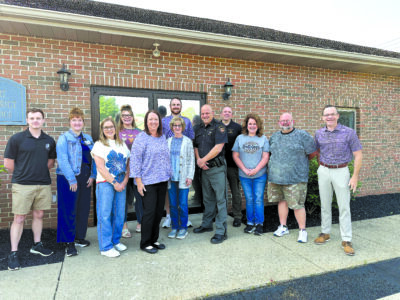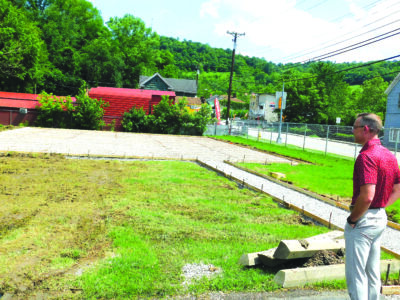Local hospitals preparing for projected surge of COVID-19 patients

T-L Photo/SHELLEY HANSON LOCAL HOSPITALS, such as WVU Medicine Barnesville Hospital shown here, are preparing for a potential surge of coronavirus patients at the anticipated height of the virus in the coming weeks.
MARTINS FERRY — As local caseloads grow, area hospitals are preparing for a potential surge in patients because of the novel coronavirus pandemic.
On Saturday, Monroe County confirmed its first two positive test results and Belmont County added three positive test results, for a total of 17.
Wheeling Hospital CEO Douglass Harrison said his hospital is working with others to ensure it can handle a potential surge of COVID-19 patients.
“All area hospitals communicate on a daily basis regarding our surge capacity plans and how we are effectively managing patients. In the event of a surge of patients, the hospitals do have plans in place to accommodate that surge,” Harrison said. “As we have stated, this is a fluid situation and changes daily. Please be assured that your health care organizations in the region are giving this top priority and working together to manage this pandemic. We urge everyone to stay at home unless critically necessary and practice social distancing, which means 6 feet apart. We will get through this together and thank you for the continued support.”
When asked if the former Belmont Community Hospital building would be part of his facility’s plans, Harrison said Wheeling Hospital would not be using the facility, which it previously operated in Bellaire. He did not give a reason why it is not part of the plans. Wheeling Hospital stopped taking patients there last year; however, Acuity Specialty Hospital still is using a portion of the building.
The Ohio Department of Health is projecting at the height of the virus’ spread, which it projects will occur between about May 1 and mid-May, new cases statewide could surge to 10,000 people per day. The Ohio Hospital Association has 188 member hospitals. There are about 34,000 total hospital beds in Ohio hospitals, according to published reports.
Harrison Community Hospital in Cadiz, an affiliate of Wheeling Hospital, also is preparing for increased numbers of coronavirus patients. Like most other hospitals across the state, Harrison has stopped elective surgeries to free up bed space and resources such as personal protective equipment.
“Our team has done an amazing job of preparing for this outbreak,” said Harrison Community Hospital Administrator Tony Martinelli. “We opened an incident command center on March 13 and have daily calls to track any concerns and keep everyone up to date with the latest developments. With the help of our partners at Wheeling Hospital and WVU Medicine, we have been able to be plugged into a larger network, which has been fantastic.”
City officials in both Martins Ferry and Wheeling are trying to get East Ohio Regional Hospital and Ohio Valley Medical Center, respectively, reopened since their closures last year by Alecto Healthcare Services. The U.S. Army Corps of Engineers recently toured OVMC to see if it could be used during the surge. The information they collected will be reviewed by FEMA and West Virginia officials. EORH also was recently toured by officials in Ohio, Rob Sproul, deputy health commissioner for the Belmont County Health Department, said.
Both Wheeling and Harrison hospitals both have enough ventilators at this time, said spokeswoman Thea Gompers.
“We assess the region’s ventilator use on a daily basis and we have surge plans in place,” she added.
WVU Medicine Barnesville Hospital President and CEO David Phillips said his facility is conserving PPE and taking other steps as well.
“We are continuing to test patients who come to the hospital and are symptomatic. We are working in conjunction with the Belmont County Health Department and Ohio Hospital Association and are very grateful for our clinical and management affiliation with WVU Medicine. The agreement is providing our hospital with greater access to necessary life-saving equipment for our staff and the patients who test positive for COVID-19,” he said.
“Our plans continue to be the same as always, deliver the best care possible to every patient, but now we are taking very stringent precautions to protect our front line staff from becoming infected, so they can continue to care for those community members who have become ill with this aggressive virus. Safety measures and precautions have also been put in place at the hospital and our physician offices, such as a no visitation policy for patients. Only the patient is permitted to attend an appointment with a provider, or ordered testing/procedures, and non-essential staff is working from home.”
Phillips said elective surgeries also have been canceled or postponed throughout the entire WVU Medicine System to conserve PPE and for patient safety.
“Patient rooms are prepared and reserved for the expected surge of COVID-19 patients in the coming weeks. We are continuing to work with local and state emergency personnel and Barnesville business leaders to determine what off-site locations can be utilized, if there is a necessity due to a patient surge,” Phillips said. “At this time, we have an adequate stock of PPE. Of course, as we are expecting a COVID-19 surge in the coming weeks, we are continuing to order and receive more necessary and life-saving equipment. This is where our agreement with WVU Medicine is very beneficial for Barnesville Hospital.
WVU Medicine has been granted a direct importing license to aid in receiving supplies at the lowest possible cost with an expedited timeline. Would we like to have more PPE? Yes. But, can we take care of the patients in need? Yes.
He noted the hospital has been giving COVID-19 tests for three weeks and its workers are “prepared to go the distance.”
“I can’t give enough positive accolades to our staff, administrators, physicians, and nurses who are working tirelessly to ensure the patients continue to be our No. 1 priority. They are placing themselves on the front line of this pandemic and they are doing it without a second thought. This is a very challenging time for all of us, and it is incredible to see how the community of Barnesville and the people of Belmont County are rallying around our hospital team. We have received many donations of PPE, food deliveries, and words of encouragement and we couldn’t be more thankful. Those acts of generosity are greatly appreciated,” Phillips added.
David Hess, president and CEO, of WVU Medicine Reynolds Memorial Hospital in Marshall County, said his hospital, much like all the other WVU Medicine facilities, has canceled or postponed elective surgeries to conserve PPE and for the safety of its patients.
“Patient rooms are prepared and reserved for the expected surge of COVID-19 patients in the coming weeks. We are continuing to work with local emergency personnel to determine what off-site locations can be utilized, if there is a necessity due to a patient surge,” Hess said.
He noted the hospital is currently stocked with adequate PPE.
“We are continuing to order and receive more necessary equipment, largely in part because WVU Medicine was granted a direct importing license to aid in receiving supplies at the lowest possible cost with an expedited timeline. Our team of physicians, nurses, administration, and staff has been working around the clock to ensure we are prepared for a possible surge … ,” Hess said, citing many of the same steps Barnesville is taking. “We are also providing front line staff the option to stay in local hotels rather than than travel to and from home and risking the possible spread of COVID-19 to their family members.
“With new positive numbers of COVID-19 cases climbing every day in West Virginia, we know now is the time to be ready. We need our staff healthy and prepared for what lies ahead. We are taking every step to ensure that happens.”
Both Reynolds and Barnesville have enough ventilators at this time.
“And both are continuing to receive more through donations and ordering through WVU Medicine. If there is a surge, we will need additional ventilators. But, because both hospitals are affiliated with the WVU Medicine Health System, we have a greater chance of receiving the equipment needed,” said spokeswoman Karin Janiszewski.
COVID-19 Projections:
The Institute for Health Metrics and Evaluation at University of Washington’s Covid-19 Projections site is one of the resources Wheeling Hospital and others are using to help prepare for a possible surge in cases. It gives projections, state by state, of how many hospital beds are available and will be needed at the peak of cases, along with how many ventilators will be needed to care for the sickest of patients. It also gives projections on how many people will die from the virus between now and Aug. 1.
The site projects that in Ohio, cases will peak April 19 and that during that period there will be 69 deaths per day. The total number of deaths between now and Aug. 1 is projected at 1,898 people.
In West Virginia, the site estimates that the deaths per day will peak May 15 at 15 people per day. It also projects between now and Aug. 4 that 487 people will die.
It projects there will not be a shortage of general hospital beds in either state; however, West Virginia is expected to have a shortage of 25 ICU beds.
Ohio Governor’s capacity plan:
Ohio Gov. Mike DeWine on Wednesday announced he had divided the state into three separate zones to deal with potential hospital capacity issues. The state already was divided into eight hospital regions with facilities in those regions already having cooperative plans in place. The new zones, however, require hospitals to revise those plans even further. The purpose is to deal with possible capacity issues during the coronavirus surge. For example, if the hospital a person would normally go to is full, then that hospital would refer that person to another hospital in the zone with available space, he said.
In addition to capacity, if a patient ends up needing more care than a hospital can give, they can be transferred to a larger hospital in that zone that can provide that extra level of care, he said.
Local counties including Belmont, Jefferson, Harrison, Monroe and Guernsey all are part of Region 8, which is now part of a larger zone containing two other regions, 4 and 7, which include the cities of Columbus and Cincinnati. According to the American Hospital Association, hospitals in Region 8 include WVU Medicine Barnesville Hospital in Belmont County; Marietta Memorial Hospital and Selby General Hospital in Washington County; Harrison Community Hospital in Harrison County; Trinity East and West in Jefferson County; Southeastern Ohio Medical Center in Guernsey County; Coshocton Regional Medical Center in Coshocton County; and Genesis Hospital in Muskingum County.
The AHA lists no member hospitals in Monroe, Morgan or Perry counties. Region 4 has 15 counties including Franklin County, which has about 20 hospitals alone. Region 7 contains 10 counties.
Phillips noted Barnesville Hospital’s surge planning does not have patients coming from other areas to his facility.
“Once we would reach internal capacity we would work to transfer patients to other areas in the state and/or neighboring states with capacity,” he said.
Martinelli said he keeps an eye on surge projections daily to help prepare Harrison.
“I speak daily with hospital administrators in our region, and we continue to monitor the surge predictions. Hospital capabilities and patient needs weigh into any decisions we might consider as the situation changes,” he said.




